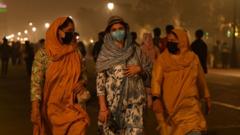As India's toxic air pollution becomes a crucial public issue, it paradoxically remains largely unaddressed in the nation’s cultural narratives. Experts emphasize the need for films and literature to reflect the profound impact of pollution on daily life.
India's Air Pollution: A Silent Crisis Lacking Representation in Popular Culture

India's Air Pollution: A Silent Crisis Lacking Representation in Popular Culture
Despite the severe air quality crisis in India, the topic finds little representation in mainstream films and literature, raising questions about societal awareness.
In the 2016 Bollywood film "Pink," a memorable scene features Amitabh Bachchan's character stepping into the smog-filled streets of Delhi wearing a mask. This poignant moment, however, is one of few instances in which Indian cinema acknowledges the dangerous air pollution that plagues many regions of the country yearly. Unlike other natural disasters such as the floods in Uttarakhand or Kerala that have inspired cinematic portrayals, the pervasive issue of air pollution remains absent from popular culture narratives.
Siddharth Singh, author of "The Great Smog of India," labels this omission a "big failure," advocating for more accessible discussions about pollution rather than relying solely on academic discourse. He argues that terms like PM2.5 or SO2 mean little to the general public, thus shifting the narrative into a space where it can be more widely understood. Similarly, Amitav Ghosh, in "The Great Derangement," highlights the unsettling acceptance of climate change amongst people, noting that such issues do not stimulate the dramatic storytelling that resonates in contemporary fiction.
While pollution's complex impact on health is evident, filmmakers grapple with the challenges of portraying its effects in a visually engaging manner. Documentaries like Shaunak Sen's "All That Breathes," which revived interest in the subject by telling the story of two brothers treating injured black kites amidst Delhi's pollution, have tackled these themes effectively. Sen insists on the importance of relatable storytelling that intertwines grand themes like the Anthropocene with everyday realities.
Veteran filmmaker Nila Madhab Panda echoes this sentiment, emphasizing the necessity of engaging storytelling to communicate climate change issues. Panda's narrative work, beginning with his documentary “Climate’s First Orphan,” evolved into mainstream films aimed at broadening the audience's awareness through entertainment. He describes his astonishing experience transitioning from Odisha's four-season ecosystem to Delhi's contrived environment where basic necessities like air and water are commodified.
Despite commendable efforts in documentaries and selective films, contemporary English writers and filmmakers continue to struggle with the task of humanizing pollution narratives. Singh notes that many individuals who could share these experiences remain invisible in discussions surrounding air pollution's toll. With the proliferation of social media, memes and viral images have become a significant means of articulating the gravity of air pollution, occasionally sparking public engagement.
To spark a collective response for change, Singh hopes the creative expressions around pollution can gain momentum and catalyze action from those in power. As the air quality crisis remains a silent plague in India's cultural discourse, there lies an urgent need for art to reflect the stark realities faced by millions.


















